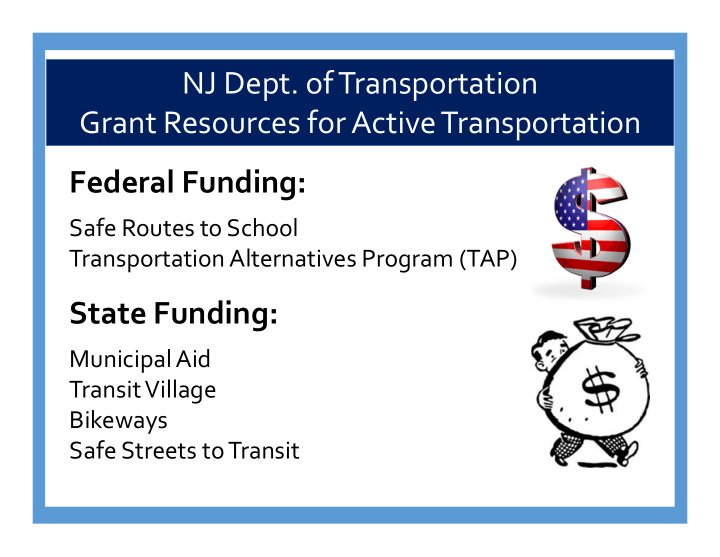



NJ Dept. of Transportation Grant Resources for Active Transportation Federal Funding: Safe Routes to School Transportation Alternatives Program (TAP) State Funding: Municipal Aid Transit Village Bikeways Safe Streets to Transit
Safe Routes to School (SRTS) Grants Program Goals 1. Where it’s safe, get kids walking and biking. 2. Where it’s not safe, make it safe. 3. Encourage children, including those with disabilities, to walk & bicycle to school. SRTS Grant Increase walking & bicycling • Improve safety • Reduce traffic & fuel consumption • Reduce air pollution • Organize large projects into phases of no more than approx. $300,000
Safe Routes to School (SRTS) Grants Who is eligible to apply? • Municipalities • Counties • School districts and schools What projects are eligible? • Infrastructure projects that enable children in grades K ‐ 8 to walk and bicycle to school • Within 2 miles of a K ‐ 8 school
SRTS Infrastructure Grant Examples Projects can include installation of: ADA compliant sidewalks • On and off ‐ road bicycle facilities • Trails to schools • Bicycle parking • Day ‐ lighting crosswalks • Traffic Calming: • o Lighted crosswalks, flashing crosswalk signs, permanent radar display, speed tables, raised crosswalks, raised intersections, bulb outs Pedestrian bridges to school • Not eligible: Education programs • Projects that only serve high schools • Projects that only serve to make drop ‐ off and pick ‐ • up zones easier to use
Transportation Alternatives Program (TAP) What are TAP projects? • Community ‐ based, local level • Non ‐ traditional surface transportation projects ( both land & water) Expand travel choice Strengthen local economy Improve quality of life Protect the environment $150,000 – 1 million per project •
Transportation Alternatives Program (TAP) Who is eligible to apply? • Local Governments • Regional Transportation Authorities • Transit Agencies • Natural resource or public land agencies • Tribal Governments • Any other local or regional governmental entity with responsibility for oversight of transportation (other than an MPO or State Agency) • Non profits that are responsible for administration of local transportation safety programs are eligible under FAST Act.
Transportation Alternatives Program (TAP) 7 Eligible Categories with a Transportation focus: 1) Design/construction of on ‐ & off ‐ road trails for pedestrians, bicyclists & non ‐ motorized forms of transportation. 2) Conversion/use of abandoned railroad corridors for trails for pedestrians, bicyclists, non ‐ motorized transportation. 3) Construction of scenic turnouts, overlooks and viewing areas 4) Historic preservation/rehabilitation of historic transportation facilities both land and water.
Transportation Alternatives Program (TAP) 7 Eligible Categories with a Transportation focus: 5) Community improvement activities (specifically streetscaping, corridor landscaping). 6) Environment mitigation to address stormwater management, control & water pollution. prevention/abatement related to highway construction. 7) Reduce vehicle ‐ cause wildlife mortality or restore/maintain connectivity among terrestrial or aquatic habitats.
Federal Grant Application Strategies • Pick the correct program for the project • Apply for multiple programs if appropriate • Review NJDOT handbooks • Prepare application based on program criteria • Be thorough. Rating based on content of application. • Include all requested information such as maintenance commitments, letters of support, etc. • Don’t assume raters know the project. Application must stand on its own merit. • Indicate construction readiness. Discuss status of permits, right of way, and utility relocations • Secure local support • Past performance counts. Ensure previously funded projects are awarded and closed ‐ out within required time frames • Assess organization’s ability to administer a federal ‐ aid project and prepare accordingly
NJ Dept. of Transportation Grant Resources for Active Transportation State Funding: Municipal Aid Transit Village Bikeways Safe Streets to Transit
Other NJDOT Programs Bike/Pedestrian Planning Assistance Since 1996, plans in 75+ towns On ‐ call consultants Types of projects: bicycle and pedestrian circulation studies, pedestrian safety assessments, trail feasibility studies, bikeway plans, crosswalk improvement plans, etc.
Thank you!! Any questions?? Elise Bremer ‐ Nei, AICP/PP Bicycle and Pedestrian Coordinator New Jersey Department of Transportation Office of Bicycle and Pedestrian Programs 609 ‐ 530 ‐ 2765 elise.bremer ‐ nei@dot.nj.gov
Recommend
More recommend